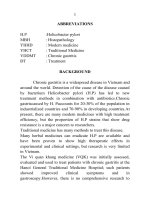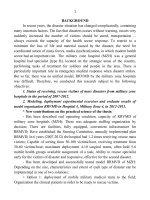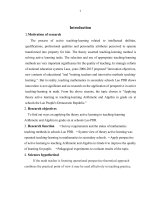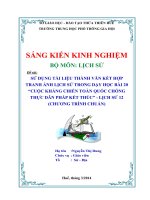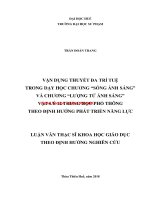Tóm tắt tiếng anh: Vận dụng tiếp cận lịch sử trong dạy học Sinh học cấp Trung học phổ thông.
Bạn đang xem bản rút gọn của tài liệu. Xem và tải ngay bản đầy đủ của tài liệu tại đây (237.49 KB, 28 trang )
MINISTRY OF EDUCATION AND TRAINING
HANOI NATIONAL UNIVERSITY OF EDUCATION
----------------------------------------
DO THUY LINH
APPLYING HISTORICAL APPROACH
IN TEACHING BIOLOGY SUBJECT
AT HIGH SCHOOL LEVEL
Major: Theory and Teaching methods of Biology
Code: 9.14.01.11
DOCTORAL THESIS IN EDUCATIONAL SCIENCE
Hanoi, 2023
The thesis has been completed at
HANOI NATIONAL UNIVESITY OF EDUCATION
Supervisors:
Assoc. Prof. Le Dinh Trung (Hanoi National University of
Education)
Assoc. Prof. Mai Van Hung (VNU University of Education)
Reviewer 1: Assoc. Prof. Nguyen Phuc Chinh
Thai Nguyen University of Education
Reviewer 2: Assoc. Prof. Nguyen Duan
Hue University of Education
Reviewer 3: Assoc. Prof. Nguyen Lan Hung Son
Hanoi National University of Education
The thesis shall be defended in front of the Thesis Commitee at
Hanoi National University of Education ……………….. 2023
The thesis can be found at: National Library, Hanoi or Library of Hanoi
National University of Education
INTRODUCTION
1. Reasons for choosing the topic
1.1. Starting from the goal of reforming general education
In the context of changing goals of general educational development to
develop the competency of students, giving students the opportunity to
directly experience, learn about things and phenomena through learning
about their origins, their evolution and development over time.
1.2. Stemming from the current educational situation in our country
One of the very effective approaches to provide knowledge in a
complete, systematic and inherited manner, thereby improving the
comprehensive competency of learners is teaching from the perspective
of HA (HA) .
1.3. Derived from the characteristics of Biology subject
Biology subject is characterized as an experimental science, in which
knowledge is built on observed phenomena and experimental results
through scientific research topics associated with practice, in which,
learners need to be tested directly to check the correctness of the
knowledge they have learned.
1.4. Starting from the value of approaching history as a method, a
way, a teaching method to develop critial thinking for students.
HA not only helps learners acquire knowledge in a logical and
systematic way; Using a historical perspective to organize teaching
Biology will contribute to helping learners develop creative freedom,
and at the same time improve some general competencies such as
problem
solving,
creativity
and
other
competencies.
Specific
competencies in Biology such as the ability to perceive scientific
knowledge and the ability to research biological sciences through the CT
ability of learners.
From the above reasons, the thesis selects and researches the topic:
1
Applying historical in teaching Biology subject at high school level"
"
.
2. Research purpose
Based on the HA, develop a process to design teaching topics in Biology
- Genetics section, and the process of teaching these topics to form and
develop CT competency, advocate for students, contributing to
improving the quality of knowledge of the Genetics section.
3. Research Limits
Genetics research is inherited, genetic knowledge is invented by
scientists, developed over time with historical nature, the following
invention complements and perfects the previous one. Therefore, the
thesis chooses research applying the HA to organize teaching of the HA,
in order to develop CT competency for students, contributing to
improving the quality of teaching and learning Biology.
4. Objects and research objects
4.1. Research subjects
The process of designing and teaching genetics topics according to HA
to develop CT for students.
4.2. Research object
The teaching and learning process of Genetics at high school according
to HA.
5. Scientific Hypothesis
If the knowledge content of the Genetics section in the Biology program
is built into teaching topics in the direction of applying the HA and
proposing the organizational process of teaching these topics, it will be
forming and developing students' CT competency, contributing to
improving the quality of knowledge of Genetics.
6. Research mission
- Research on theoretical and practical basis for applying HA to teaching
Biology in general and part genetics in particular in order to develop CT
2
for students.
- Define the principles and design process of the topic Genetics
according to HA.
- Develop a process of teaching genetics topics according to HA.
- Determine the structure of CT and teaching methods according to HA
to develop CT for Students.
- Determining criteria for assessing students' CT ability in teaching
according to HA.
- Conduct pedagogical experiments to confirm and evaluate the scientific
hypothesis that has been raised.
7. Research Methods
During the research process, the thesis uses the following research
methods:
7.1. Theoretical research methods
7.2. Practical investigation method
7.3. Expert consultation method
7.4. Experimental method of pedagogy
7.5. Methods of processing data by mathematical statistics
8. New contributions of the thesis
- Researching and building theoretical and practical bases on the
application of HA in teaching, especially in teaching genetics.
- Researching and building theoretical and practical bases on CT,
applying HA in teaching to develop CT for students.
- Identify principles and design processes for genetics topics applying
the HA.
- The system of Genetics topics applying HA is built to teach the
inherited genetics part, showing the logical relationship between the
topics.
- Proposing the process of using the teaching topics of the section
3
Genetics applying HA to develop CT for students.
- Determining the competency structure of CT, measures to train CT,
tools to assess CT for students through teaching and applying HA.
9. Structure of the thesis
In addition to the introduction, conclusions, recommendations,
references and appendices, the thesis is presented in 3 chapters:
Chapter 1: Overview of theoretical and practical issues related to the
topic.
Chapter 2: Applying the historical approach in teaching the part of
Genetics in high school to develop critical thinking competency for
students.
Chapter 3: Pedagogical Experiment
CHAPTER I. THEORETICAL BASIS AND PRACTICE OF
THE TOPIC
1.1. Research situation in Vietnam and in the world related to the
topic
1.1.1. On the historical approach to teaching
1.1.1.1. In the world
Many teaching models have been put to the test and have shown
positive results in improving the level of scientific knowledge
acquisition. At the same time, when surveying students’ attitudes
towards natural science subjects that integrate historical knowledge,
most students admitted that they were more interested and active in
learning, continuing obtained the way of thinking, thinking and
concluding the problem of the previous scientists. HA helps to bridge the
gap between science and life, helping students understand the objective
development of "dry" inventions, laws, and theorems, thereby predicting
future next development direction. Besides, through the process of
learning about the birth of inventions, laws, theorems, etc., learners will
understand the efforts of previous scientists, thereby having a respectful
4
and serious attitude. be more engaged in absorbing scientific knowledge,
creating scientific questions, thinking reasoning to solve these questions.
1.1.1.2. In Vietnam
Although the view of HA is not a new one, in Vietnam, there have not
been many studies on the application of this point of view in teaching.
The HA is mostly applied in social science and industrial engineering
subjects. Thus, it can be said that teaching according to HA is still a very
new and open approach and has not received much attention.
1.1.2. About critical thinking competency and developing critical
thinking competency
1.1.2.1. In the world
The focus on forming and developing CT for students has been
around for a long time. About 2500 years ago, the philosopher Socrates
mentioned the importance of developing CT for learners. Later on, CT
was studied more clearly and deeply. CT has become an indispensable
competency in all fields of science, especially in the field of education.
There has been a lot of research on the development of CT in education.
1.1.2.2. In Vietnam
In Vietnam, there have been quite a few studies on CT and the
development of CT in education. Most of the research works confirm
that CT is very important to help students perceive the problem in a
multi-faceted, accurate and complete way, and at the same time evaluate
the problem solving options to solve the problem. Find the best solution,
fix the mistakes.
1.1.3. Teaching according to historical approach to develop critical
thinking competency
1.1.3.1. In the world
Gericke, Smith and Burian designed 5 models of gene function according to
the logic of gene discovery, clarifying the characteristics of genes in each
model and advantages and disadvantages. of each model, how the
5
limitations of the previous model were overcome by the following model.
1.1.3.2. In Vietnam
In general, in Vietnam, methods to improve the quality of teaching in the
section Genetics have been studied quite early and deeply. The teaching
methods
are
aimed
at
comprehensively
developing
different
competencies and competencies for students, including problem-solving
ability, thereby partly training students’ CT. In essence, the component
competencies of CT are similar to the component competencies of
problem solving (Garrison, 2016).
1.2. Rationale for the thesis
1.2.1. Access to history
1.2.1.1. The concept of Historical approach
In our opinion, it is possible to define HA as a method, a way to
understand a certain thing or phenomenon based on the past arising and
development process of human perception of things, phenomena. from
which to understand the fundamental law of motion.
1.2.1.2. Historcal approach in teaching
In this study, we use the phrase HA with its connotation as a
teaching measure. Teaching method applying HA is a method of
organizing and teaching to repeat the thinking and discovery process of
scientists to find out knowledge that is the essence of objective things
and phenomena. Since then, students not only acquire scientific
knowledge but also practice CT through understanding logical thinking
to find knowledge.
1.2.1.3. Teaching topic applying historical approach
In this study, we use the term "genetics" with the meaning of a
systematic, closely related set of concepts and activities. , the function of
genes, at different stages in the history of the study of Genetics. Each
genetics teaching topic using HA is a "model" of genes (nature, activity,
6
function) at times of landmark change. Thereby, students will realize that
the research process on Genetics is continuous, and is expanded and
updated very quickly. Students also form and develop skepticism when
faced with scientific statements about Genetics, thereby proposing
scientific hypotheses to explain their skepticism and proving scientific
hypotheses.
1.2.1.4. Methods of applying the historical approach in teaching
With the Biology subject, specifically the Genetics section, author Lin
and his colleagues designed the Historical Episodes Map (HEM) model,
which aims to provide a complete view of the development of Genetics
theory. Classic with more than 20 chapters, based on four storylines. are
Genetic line, Reproductive line, Cytology line, and Technology line,
respectively (C. Lin et al., 2010).
1.2.2. Critical thinking competency
1.2.2.1. Critical thinking competency concept
CT expressed in the teaching of the Genetics topic applying HA is a
dialectical thinking ability, which helps learners explore genetics
knowledge in many different ways in order to uncover contradictions.
hidden contradictions within or between theories of Genetics; propose
solutions, reasonable arguments to prove those options; objectively
evaluate solutions; thereby realizing that the study of Genetics is always
in a dynamic state and predicting the next development trend.
1.2.2.2. The structure of Critical thinking competency
Many authors in the world and in Vietnam have researched and
determined the CT structure that includes many different competencies
and attitudes.
1.2.2.3. Measures to develop Critical thinking competency for students
CT needs to be formed, developed and practiced continuously through an
active and active teaching and learning process.
7
1.2.2.4. Measures to assess Critical thinking competency
Subjective tools such as essay questions/questions and case studies that
requires students to apply what they've learned to a new situation will
help assess students’ CT effectively. than objective tools such as
true/false questions or standardized, synchronized multiple choice
questions.
1.2.3. Developing critical thinking competency through teaching using
historical approaches
With the orientation of the topic is to apply the HA in teaching the
Genetics section in order to develop CT, we use a system of
contradictions. The contradictions used are those that arise between the
views of different scientists about a particular theory of Genetics, or
those that arise when studying the theory of Genetics at different points
in time. different stages of discovery, or contradictions between theory
and practice. The research results support a new theory that will inherit
the correct aspects but at the same time negate the limitations of the
previous theory to solve the new requirements that have not been solved
before. Students will learn genetics knowledge in many different aspects,
thereby forming and developing the ability to analyze, synthesize,
evaluate information, give opinions and arguments to prove their point of
view. their points, and also compare their solutions with those of other
individuals and previous scientists.
From that, we propose a structure of CT competency developed through
teaching applying HA including 05 component competencies as
described in Table 1.3.
8
Table 1.3. The competencies of CT and the highest expression of each
competency
Competencies
View scientific theories
comprehensively and objectively.
Analysis of contradictions that arise
within or between scientific theories.
Propose and infer, demonstrate how
to resolve conflicts and identify the
logic of knowledge development.
Objectively evaluate your own
conflict resolution, thereby
discovering the
advantages/disadvantages of each
solution.
Detect mistakes in the process of
resolving
conflicts
and
take
measures to correct them.
1.3. Practical basis
Highest expression
State contradictions within or
between scientific theories into
questions.
Identify
the
content
of
knowledge related to the
resolution of small problems in
conflict.
Arguing, explaining how to
resolve conflicts and making
predictions about the next
development trend.
Analyze the pros/cons of your
own solutions.
Correct your mistakes
change accordingly.
and
1.3.1. Survey purpose
Find out the actual level of interest of students and teachers in the
Genetics section; Find out the current status as well as the level of
interest and interest in the teaching and learning method of the Genetics
applying HA of students and teachers; Level of assessment of students’
CT.
1.3.2. Survey content and tools
Survey content: The level of interest of students and teachers in
teaching the Genetics section, The current situation of teaching and
learning the Genetics under the current HA, The views of teachers and
students on the application of HA in the organization of teaching the
9
section Genetics, Assessment level of students’ CT.
Survey tool: students’ survey form; teachers’ opinion survey form.
1.3.3. Survey audience
We surveyed 510 students in grade 12 after completing the Genetics
section in grade 12 - high school year 2019 - 2020 (These students
belong to classes that did not participate in pedagogical experiments) and
45 Biology teacher teachers.
1.3.4 Investigation results and discussion
1.3.4.1. Students' interest in the Genetíc
Student's interest in learning about genetics knowledge
The results showed that the majority of students had a rather
indifferent attitude or did not feel interested when learning about
genetics knowledge.
What are the difficulties in teaching and learning the Genetics
module? (multiple answer question)
The results show that a large percentage of students (51.4%) can
understand each basic concept of the Genetics section independently
(such as DNA, genes, alleles, chromosomes, ...) but not establish
relationships between these concepts. From this result, it can be affirmed
that there is a need for a more appropriate teaching method for students
to perceive genetic knowledge according to scientific logic, to help
students learn and connect genetic knowledge according to their own
nature. matter.
1.3.4.2. The current situation of applying the teaching method of
Genetics according to the historical approach
Actual situation of applying HA in teaching Genetics
The results show that the majority of teachers ask students to learn
genetics knowledge based on studying textbooks, then answer
orientation questions or do exercises (accounting for 75% for students).
10
and 83.2% for teachers). Only a small percentage of teachers have begun
to apply HA in teaching genetics by designing learning topics according
to HA (accounting for 12.2% for students and 8.9 for students and 8.9).
% for teachers) and integrates knowledge of many other fields to
improve the awareness of Genetics knowledge (12.8% for students and
7.9% for teachers).
Perspectives of teachers and students about applying HA in
teaching genetics
76.2%
of
students
and
75.6%
of
teachers
consider
it
necessary/necessary to organize for students to learn genetics knowledge
during its development. Although teachers and studetns show a high level of
interest in discovering Genetic knowledge by logic of development, in
practice, the frequency with which teacherss apply approaches to applying
HA in teaching Genetic is not high because of many difficulties. This result
further shows the need for research to propose an effective process of
applying HA in teaching genetics.
1.3.4.3. Level of assessment of students' critical thinking
The survey results showed that basically, the majority of students had
a sense of training to develop CT, resulting in the percentage of students
who agreed to completely agree. The attention for the manifestations of
critical thinking is quite high (about 44% - 61.8%). However, there is still a
fairly large percentage of students expressing uncertainty and uncertainty
about the extent to which the manifestations of Criticism (about 31.8% 45%) will be achieved.
When surveying the linear correlation between 09 measures of
applying HA in teaching genetics with expressions of critical thinking, the
results show that between the measures and the expression of CT are closely
correlated with each other.
From the above comments, we found that students did not really love
11
Biology in general and the Genetics section in particular. An urgent need is
to develop a teaching method to ensure that students understand the core
knowledge, recognize the laws of movement and objective development of
genetic knowledge. Thereby, student will develop not only the ability to
perceive genetic knowledge, but also develop and foster CT through
exploring the way of thinking to discover that knowledge.
CHAPTER 2. APPLICATION OF HISTORICAL APPROACH IN
TEACHING OF GENETICS IN HIGH SCHOOL FOR THE
DEVELOPMENT OF CRITICAL THINKING COMPETENCY
FOR STUDENTS
2.1. Analysis of the goals and structure of the content of the Genetics
section in the general education curriculum of Biology
2.1.1. Objectives of High School Genetics
The core goal of teaching Genetics is to teach about the structure and
functioning of genetic material (molecular-gene level or cellularchromosome level) through generations of cells and individuals. ,
population. Since then, students learn about the application of Genetics in
the fields of production, life, medicine, etc. in modern times.
2.1.2. Structure of the section Genetics
Studying the content of the section Genetics, it can be seen that the
main content of this section is to clearly define the nature of heredity, which
is the transmission of genetic material from one generation to another
generation according to the mechanisms/regulations. strict laws. Discoveries
about genes act as the "backbone", the "red thread" throughout the section
Genetics, the following discoveries will negate/complement, expand the
previous discoveries.
2.2. Developing a design process for genetics topics applying
historical approach to develop critical thinking for students
12
2.2.1. Principles of developing the design process for genetics topics
applying historical approach to develop critical thinking for students
1) Ensure focus on scientific issues and must be based on curricula
and textbooks; as well as ensure implementation time.
2) The selection of knowledge to be integrated into the topic should
be ensured based on the students’ cognitive ability as well as the level of
need to integrate, the level of evoking creative curiosity in students.
3) When applying HA to design topics, it is necessary to ensure the
scientific logic of the content of the lesson knowledge.
4) Make sure to highlight the inherited characteristics of Biology
knowledge in general and Genetics in particular.
5) Teaching topics applying HA need to be sure to highlight the
inherited characteristics of knowledge of Biology in general and
Genetics in particular.
6) When designing a teaching topic using the Genetics, make sure
to include at least one contradiction that requires students to think and
solve.
2.2.2. The process of designing genetics topics using historical
approaches to develop critical thinking for students
It is possible to generalize the design process of topics applying HA
as shown in diagram 2.1:
13
Step 1. Analyze the content and objectives of the section
Genetics to determine the historical logic
Step 2. Determine the name, teaching duration
and objectives of the topic
Step 3. Identify key knowledge and
inconsistencies in the topic
Step 4. Build a teaching process with activities
towards developing CT
Step 5. Build testing and evaluation tools
Diagram 2.1. The process of designing teaching topics applying HA
2.2.3. Example of applying the process to design a teaching topic
Genetics using the historical approach
We analyzed, for example, the process of designing the teaching
topic "Mendelian Model".
2.2.4. Genetics topics were developed using a historical approach
Table 2.7. The logic of developing a view of genes through genetic
Model of
Population
genetics
14
topics using a HA
Genes are:
- transmission unit: exist in pairs in body
cells, passed from parents to offspring
- function unit: specifies a certain trait.
Genes are:
- independent transmission unit: has a
definite location (locus) and is distributed
along the chromosome,
- function unit: specifies a certain trait,
- recombination unit: gene is the smallest
unit of heredity, between genes that are
capable of crossing over with each other.
- mutation units: genes capable of being
mutated to produce a new phenotype.
Gene is the function unit: regulates the
synthesis of enzymes.
Genes are:
- transmission unit, function unit: is a
segment of a DNA molecule, carrying
information coding for a polypeptide chain
or an RNA molecule.
- recombination unit: the smallest genetic
unit where crossover can occur. Crossover
can take place between nucleotides in the
same gene.
- mutation unit: a gene capable of being
mutated in structure, involving a pair of
nucleotides, resulting with or without
altering the composition and sequence of
amino acids in the polypeptide chain,
thereby having or does not change the
function of the protein.
A gene is a set of genome sequences (DNA
or RNA), coding for an independent
product or a combination of products with
closely related functions.
2.3. The process of organizing teaching on the topic of Genetics
according to historical approach to develop critical thinking
capacity for students
2.3.1. General process of teaching genetics topics according to
historical approach to develop critical thinking capacity for students
Based on the research results of some authors and the typical
characteristics of teaching under HA, we have built a process of teaching
the topic of Genetics according to HA as shown in the diagram 2.3 as
below.
The process
Step 1. Introduce the topic and its contradictions
of
15
organizing
and
teaching
Step 2. Guide students to resolve conflicts
historical
approaches
to develop
Step 4. Assess and correct mistakes in perception and conflict resolution
critical
thinking
competency
for students
Step 5. Analyze and draw logic to develop genetics knowledge through
each topic in the direction of critical thinking competency development
Diagram 2.3. The process of organizing and teaching genetics topics
using historical approach to develop CT for students
2.3.2. Example illustrating the organization of teaching on the topic
Genetics using historical approach to develop critical thinking for
students
We have analyzed an example illustrating the organization of
teaching the topic "Molecular Modeling".
2.3.3. Measures to train critical thinking through teaching genetics
topics using historical approaches
To train critical thinking for high school students through genetics
topics applying HA, the following measures can be used: Introduction of
contradictions; Short description of historical events for the main body
of the subject; Case studies appearing in the topic; Ask provoking
questions for students brains to research the topic.
2.4. Assessing the development of critical thinking of high school
students through teaching the topic genetics using historical
approach
2.4.1. Criteria for assessing critical thinking through teaching the
topic of Genetics applying historical approach
We focus on monitoring and evaluating the performance of 01
16
behavioral expression for each component competency of CT
competency.
Table 2.8. Criterion table for Criterion Thinking
Criteria
A. To view Genetics
theories comprehensively
and objectively
B. Analyze conflicts that
arise within or between
Genetics theories.
C. Propose and infer,
demonstrate how to
resolve conflicts and
identify the logic of
developing knowledge of
Genetics.
D. Objectively assess
your own conflict
resolution, thereby
discovering the
advantages/disadvantage
s in each solution.
17
Expression
State
contradictions
within or
between
scientific
theories into
questions.
Identify the
content of
knowledge
related to the
resolution of
small problems
in conflict.
Arguing,
explaining how
to resolve
conflicts and
predicting the
logic of
developing
knowledge of
Genetics.
Analyze the
pros/cons of
your own
solutions.
Level of achievement at each behavioral
expression
A1. The question is not stated or the question
does not accurately reflect the content of the
conflict.
A2. The question can be stated, but the
question is not coherent, not focused,
reflecting the focus of the content of the
conflict.
A3. Speak into concise, coherent, focused
questions that reflect the heart of the content of
the conflict.
B1. Acquiring intellectual information but
hardly involved in conflict resolution.
B2. Identify some background information and
knowledge related to conflict resolution.
B3. Explain and adequately explain the
information and knowledge necessary for
conflict resolution.
C1. Not knowing how to argue and explain
how to resolve conflicts.
C2. Give some basic arguments to argue about
how to resolve the conflict but not enough and
convincing.
C3. Provide strong, clear and convincing
arguments, arguments and arguments to argue,
explain how to resolve conflicts and make
predictions about the next development trend.
D1.
Not
realizing
the
advantages/disadvantages in his own way of
resolving conflicts.
D2. I have realized that my own way of
resolving conflicts has certain
advantages/disadvantages but have not yet
analyzed it.
D3. Identify and analyze the
advantages/disadvantages of your own
solution compared to other solutions.
